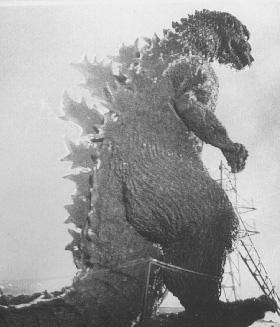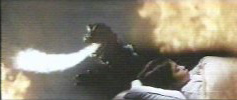
Evolution
The American version of the first Gojira film, Godzilla, King of the Monsters, included many modifications to suit American audiences. These modifications were indicative of the aim of the Japanese creators to better target an American audience, to incorporate the Self into the Other, while the film itself revitalized the stagnant Japanese film industry.
The actor Raymond Burr was added into the film to introduce a classic American hard-boiled detective into the non-American film.

Certain scenes were also cut out of the monster’s destruction of Tokyo, which was "thought to be too poignantly reminiscent of Hiroshima" (Tanaka).

With later Gojira movies, the editing for American appeal was included in the Japanese version; again adopting the Other to reflect in the Self. The third Gojira film, Kingu Kongu Tai Gojira (King Kong vs Godzilla, 1963) presented a monster with a more "anthropomorphic personality" than the first Gojira. In his study of classic movie monsters Donald F. Glut notes that, "To survive through any number of sequels...and not go to the extinction of so many other city rampaging prehistoric beasts, Godzilla would need personality" (Glut). Toho Productions, therefore, renovated the rubber monster costume to be less terrifying than the original.
 became...
became... 
The teeth were shortened, the ears were removed and the eyes made larger and lidded, allowing for a greater range of expression.
 became...
became... 
In 1965, with the filming of the fifth Gojira thriller, Ghidrah: The Three-Headed Monster, (Gojira joins Radan and Mothra to save Tokyo) Toho realized that their primary audience was children and Gojira should be more friendly and frivolous. For American viewers; this presents in essence a "diffusion" of the nuclear bomb, America’s release of guilt for the bombing. His battles assume a somewhat slapstick air, and for once poor Gojira is allowed to leave in peace rather than be bombed, de-oxygenated, buried in ice, or entangled in webs at the end of the film.
By the tenth movie, Oru Kaiju Daishingeki (Godzilla's Revenge, 1969), Gojira is a superhero to children, and his son

Minya, Godzilla's baby, is able to shrink in size to befriend a lonely young boy.

Surprisingly, Gojira speaks in the twelfth film, Gojira Tai Gaigan (Godzilla vs. Gaigan, 1971) and emulates tag-team wrestlers in the thirteenth film, Gojira Tai Megaro (Godzilla vs Megaron, 1973). All in all he saves Tokyo or Osaka or some part of Japan approximately eleven times. In so doing he evolved from a horrifying beast who instilled nothing but panic and terror to a friend and a buddy, called on in times of need.
 godzilla godzilla |
 introduction introduction |
 genesis genesis |
 evolution evolution |
 conclusion conclusion |